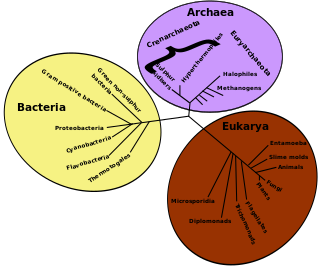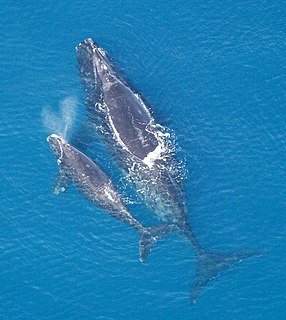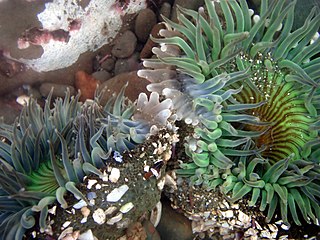
Ecology is a branch of biology concerning interactions among organisms and their biophysical environment, which includes both biotic and abiotic components. Topics of interest include the biodiversity, distribution, biomass, and populations of organisms, as well as cooperation and competition within and between species. Ecosystems are dynamically interacting systems of organisms, the communities they make up, and the non-living components of their environment. Ecosystem processes, such as primary production, pedogenesis, nutrient cycling, and niche construction, regulate the flux of energy and matter through an environment. These processes are sustained by organisms with specific life history traits.

In ecology, a niche is the match of a species to a specific environmental condition. It describes how an organism or population responds to the distribution of resources and competitors and how it in turn alters those same factors. "The type and number of variables comprising the dimensions of an environmental niche vary from one species to another [and] the relative importance of particular environmental variables for a species may vary according to the geographic and biotic contexts".

In ecology, a biological interaction is the effect that a pair of organisms living together in a community have on each other. They can be either of the same species, or of different species. These effects may be short-term, like pollination and predation, or long-term; both often strongly influence the evolution of the species involved. A long-term interaction is called a symbiosis. Symbioses range from mutualism, beneficial to both partners, to competition, harmful to both partners. Interactions can be indirect, through intermediaries such as shared resources or common enemies. This type of relationship can be shown by net effect based on individual effects on both organisms arising out of relationship.

In biology, polymorphism is the occurrence of two or more clearly different morphs or forms, also referred to as alternative phenotypes, in the population of a species. To be classified as such, morphs must occupy the same habitat at the same time and belong to a panmictic population.

Niche construction is the process by which an organism alters its own local environment. These alterations can be a physical change to the organism’s environment or encompass when an organism actively moves from one habitat to another to experience a different environment. Examples of niche construction include the building of nests and burrows by animals, and the creation of shade, influencing of wind speed, and alternation of nutrient cycling by plants. Although these alterations are often beneficial to the constructor they are not always.

In biology, adaptation has three related meanings. Firstly, it is the dynamic evolutionary process that fits organisms to their environment, enhancing their evolutionary fitness. Secondly, it is a state reached by the population during that process. Thirdly, it is a phenotypic trait or adaptive trait, with a functional role in each individual organism, that is maintained and has evolved through natural selection.

Evolutionary ecology lies at the intersection of ecology and evolutionary biology. It approaches the study of ecology in a way that explicitly considers the evolutionary histories of species and the interactions between them. Conversely, it can be seen as an approach to the study of evolution that incorporates an understanding of the interactions between the species under consideration. The main subfields of evolutionary ecology are life history evolution, sociobiology, the evolution of inter specific relations and the evolution of biodiversity and of communities.

In ecology, r/K selection theory relates to the selection of combinations of traits in an organism that trade off between quantity and quality of offspring. The focus on either an increased quantity of offspring at the expense of individual parental investment of r-strategists, or on a reduced quantity of offspring with a corresponding increased parental investment of K-strategists, varies widely, seemingly to promote success in particular environments.
Niche Microdifferentiation is the process a species undergoes to reach genetic diversity within that species; it is the process by which an ecotype is created. This process is regulated by various environmental influences whether they be morphological, spatial, and/or temporal. This means that a trait of one organism in one area is not advantageous for the same species in a different location: "the trait that alters the environment in a manner that is favorable to growth tends to be reinforced and this positive feedback can further, to a certain extent, modify the selection pressure on itself". For example, a species of moth which is white and lives in an area where tree bark is stripped and tree color is white will more easily survive than a white moth in a different location where trees are moss-covered and green. This leads to adaptations that allow the species to exist in a slightly different environment. Organisms within the same species can undergo phenotypic and genotypic changes due to niche microdifferentiation. Conspecific organisms can vary in color, size, diet, behavior, and morphology due to differences in environmental pressures. Related topics include epigenetics, niche differentiation, and evolutionary biology.

A generalist species is able to thrive in a wide variety of environmental conditions and can make use of a variety of different resources. A specialist species can thrive only in a narrow range of environmental conditions or has a limited diet. Most organisms do not all fit neatly into either group, however. Some species are highly specialized, others less so, and some can tolerate many different environments. In other words, there is a continuum from highly-specialized to broadly-generalist species.
Human behavioral ecology (HBE) or human evolutionary ecology applies the principles of evolutionary theory and optimization to the study of human behavioral and cultural diversity. HBE examines the adaptive design of traits, behaviors, and life histories of humans in an ecological context. One aim of modern human behavioral ecology is to determine how ecological and social factors influence and shape behavioral flexibility within and between human populations. Among other things, HBE attempts to explain variation in human behavior as adaptive solutions to the competing life-history demands of growth, development, reproduction, parental care, and mate acquisition.
Geerat J. Vermeij, is a Dutch-born professor of geology at the University of California at Davis.

Competition is an interaction between organisms or species in which both the organisms or species are harmed. Limited supply of at least one resource used by both can be a factor. Competition both within and between species is an important topic in ecology, especially community ecology. Competition is one of many interacting biotic and abiotic factors that affect community structure. Competition among members of the same species is known as intraspecific competition, while competition between individuals of different species is known as interspecific competition. Competition is not always straightforward, and can occur in both a direct and indirect fashion.
The following outline is provided as an overview of and topical guide to ecology:

The Red Queen hypothesis is an evolutionary hypothesis which proposes that species must constantly adapt, evolve, and proliferate in order to survive while pitted against ever-evolving opposing species. The hypothesis was intended to explain the constant extinction probability as observed in the paleontological record caused by co-evolution between competing species; however, it has also been suggested that the Red Queen hypothesis explains the advantage of sexual reproduction at the level of individuals, and the positive correlation between speciation and extinction rates in most higher taxa.
In behavioral ecology, adaptive behavior is any behavior that contributes directly or indirectly to an individual's reproductive success, and is thus subject to the forces of natural selection. Examples include favoring kin in altruistic behaviors, sexual selection of the most fit mate, and defending a territory or harem from rivals.
Island ecology is the study of island organisms and their interactions with each other and the environment. Islands account for nearly 1/6 of earth’s total land area, yet the ecology of island ecosystems is vastly different from that of mainland communities. Their isolation and high availability of empty niches lead to increased speciation. As a result, island ecosystems comprise 30% of the world’s biodiversity hotspots, 50% of marine tropical diversity, and some of the most unusual and rare species. Many species still remain unknown.

Ecological fitting is "the process whereby organisms colonize and persist in novel environments, use novel resources or form novel associations with other species as a result of the suites of traits that they carry at the time they encounter the novel condition." It can be understood as a situation in which a species' interactions with its biotic and abiotic environment seem to indicate a history of coevolution, when in actuality the relevant traits evolved in response to a different set of biotic and abiotic conditions. The simplest form of ecological fitting is resource tracking, in which an organism continues to exploit the same resources, but in a new host or environment. In this framework, the organism occupies a multidimensional operative environment defined by the conditions in which it can persist, similar to the idea of the Hutchinsonian niche. In this case, a species can colonize new environments and/or form new species interactions which can lead to the misinterpretation of the relationship as coevolution, although the organism has not evolved and is continuing to exploit the same resources it always has. The more strict definition of ecological fitting requires that a species encounter an environment or host outside of its original operative environment and obtain realized fitness based on traits developed in previous environments that are now co-opted for a new purpose. This strict form of ecological fitting can also be expressed either as colonization of new habitat or the formation of new species interactions.

Ecological speciation is the process by which ecologically based divergent selection between different environments leads to the creation of reproductive barriers between populations. This is often the result of selection over traits which are genetically correlated to reproductive isolation, thus speciation occurs as a by-product of adaptive divergence.











